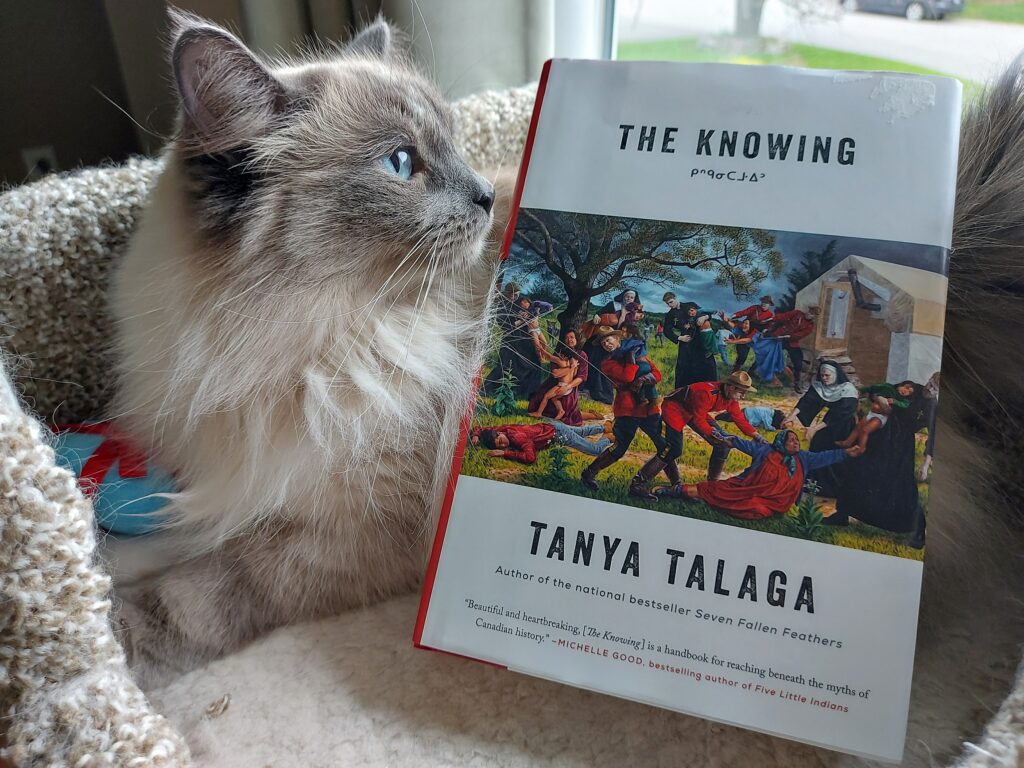The Knowing by Tanya Talaga

What drew me to Tanya Talaga’s The Knowing is Kent Monkman’s incredibly vivid painting called The Scoop that is reproduced on the cover. It is a terrifying and infuriating image of Mounties, priests and nuns tearing Indigenous children away from their desperate parents in order to take them to residential schools. Talaga’s book is about Canada’s dark history of the segregation and forced assimilation of Indigenous peoples. This is an important book to read if you want to understand why residential schools have had a lasting, traumatic impact on generations of Indigenous families.
The title of the book comes from “The Knowing”, the collected knowledge that Indigenous peoples have carried for generations about the residential schools and the abuse and deaths that occurred at them, knowledge that white people have either turned a blind eye to or do not want to believe. It was not until 2021 when the 215 possible burial sites of children who attended the former Kamloops Indian Residential School were discovered and received international attention that Canada had to own up to the role it played in funding and operating these schools. The discovery of graves at various former residential school sites has allowed Indigenous peoples to openly grieve the loved ones that are lost to them, and they are finally finding a path towards healing.
Talaga does not spare any details in recounting the horrors that the children faced at the residential schools. It is absolutely disgusting and angering how white supremacy has led to the government and religious sanctioned physical and sexual abuse of children and a complete lack of care for their wellbeing to the point that their bodies were dumped in unmarked graves dug by other children. But, as Talaga details in her book, the apologies from the Canadian government and the Catholic Church to the survivors of the residential schools mean nothing as both institutions still refuse to cooperate in handing over valuable records that would help Indigenous communities find out what happened to their relatives that went missing, and the Church is still making excuses for not forking over $20 million in reparations while it sits on billions of dollars worth of real estate and the Pope lives in a palace.
Even with all the evidence that has come to light since the discovery of the 215 graves in Kamloops, (white) people are still in denial with what happened at the residential schools. I seriously want to hit those people over the head with Talaga’s book. She is a journalist who works for The Globe and Mail. She was there in the early days after the 215 were discovered. She, like all other Indigenous peoples, has lost family members to the residential schools and has painstakingly researched this book, combing through barely legible records where the Indian agents could not even be bothered to spell people’s names correctly and interviewing Elders who attended the schools, trying to find out what happened to them.
The Knowing isn’t just about the residential schools, it is about Talaga’s own family and her quest to trace the life of her great-great-grandmother Annie Carpenter and find out why she ended up in an asylum. Talaga discovers relatives she never even knew she had, Annie’s children, many of whom died at residential schools or are suspected to have died at residential schools. There is a list of her family members at the back of the book and so many of them have “death unknown” next to their names. It is terrible to think of one’s relatives disappearing without a trace, especially if that relative is a child. By bringing her own family into the book, Talaga creates a connection with the reader so that the pain and grief she feels, and the pain and grief of her ancestors, is yours to experience as well.